A beginner's guide to shotgun chokes
by John Robinson
Australian Shooter November 2004
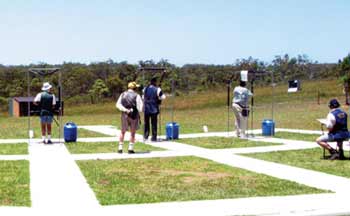
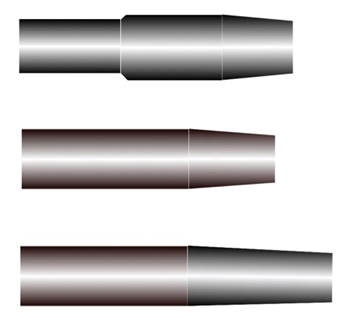
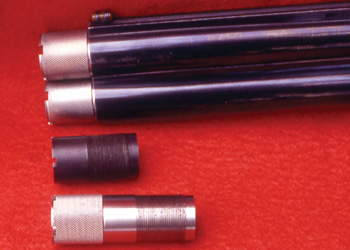 While taken for granted today, the choking of shotgun barrels was the greatest advance on shotgun performance since the invention of the smoothbore firearm.
While taken for granted today, the choking of shotgun barrels was the greatest advance on shotgun performance since the invention of the smoothbore firearm.
In the muzzleloading era, the main aim was to shove whatever was needed down the front of the barrel, so parallel bores were a desirable characteristic. In fact, the 18th-century blunderbuss firearm was a good example of making it even easier to shove as many projectiles into a barrel as possible.
One of the few things we can thank the British aristocracy for is the development of the shotgun as a sporting firearm. Bird shooting was very fashionable (and sometimes very competitive) in the days of large estates, gamekeepers and driven birds.
These recreational shooters realised it was the pattern of the shot that would determine the effectiveness of their shotguns. The very competitive nature of this social activity ensured that some attention was given by gunmakers to producing the most effective sporting guns.
The famous British gunmakers of the 19th century - Holland & Holland, Purdey, Greener, etc, built their reputations on meeting the demands of the wealthy sporting shooters of the era. Reputations were jealously guarded and for that reason the development of the shotgun choke has been claimed by a number of the protagonists.
Of these, W W Greener has the most substantial claim, supported by his classic 1888 publication, The Gun and its Development. This great book remains in print today.
By the latter part of the 19th century, choking of shotgun barrels had progressed from an art to a science, with all manufacturers of smoothbores supplying choked barrels to customer requirements.
The tightest choke constriction was called a ‘full choke’ because making the constriction any smaller did not improve the pattern performance.
A system was developed to standardise the method of specifying chokes and this resulted in a classification of five choke descriptions. The English system was logical and easy to follow, with the chokes designated: Full, ¾, ½, ¼ and cylinder. The Americans came up with their own system, with the designations: full, improved modified, modified, improved cylinder and cylinder.
The Europeans, just to be different, have a system of using asterisks or punch marks, starting with * for full choke, ** for ¾, *** for ½, **** for ¼ and CL for cylinder.
The interesting thing about choke designations relative to barrel dimensions is that the true measure of a choke’s designation is classified by how many pellets (as a percentage of the total in the cartridge) will fall in a 30" (76cm) circle at 40 yards (36m).
Thus, a full choke gun may shoot a ¾ choke pattern with a particular type of cartridge and load. The development of special cartridges and wads (such as spreader wads designed to widen the pattern) gives the shooter a great deal of control over what happens to the shot if the principles are understood.
When skeet shooting was developed after WWI in the USA, a skeet choke designation was introduced, which is a cylinder choke with a very slight constriction (about 0.004"). While this level of choke did not significantly tighten the pattern, it made the shot distribution in the pattern more uniform.
While there are a number of commercial shotgun gauges, 12-gauge is almost the only game in town for Australian shotgunners. The bore-gauge was originally developed from a system based on the number of round lead balls of that diameter to the pound. Thus 12-gauge was 12 balls to the pound.
This gives a standard bore diameter of 0.729". Many commercial shotguns may not have barrels of this exact diameter; some may be smaller or larger and may be 12½-gauge or 11½-gauge. See Table 2 for further details regarding bore diameters.
Another interesting thing about chokes is that the difference between the restriction at the muzzle and the section immediately behind it is what determines the choke performance and not the overall barrel diameter.
A method of choking called ‘jug choking’ has long been used to improve shotgun performance - by enlarging the bore for a short length just behind the muzzle. The shot column expands into this area and is then constricted again at the muzzle. Thus, a fixed choke shotgun with fairly open chokes could be converted to a tighter choked option by jug choking. This would not interfere with the original muzzle configuration.
Jug choking is becoming increasingly popular on competition shotguns. While one reason given is improved patterning, the main claimed advantage is reduced felt recoil as the shot column does not ‘hit an obstruction’ in the form of a narrower bore on the way out of the barrel.
The advent of screw-in chokes has, to some degree, solved many problems for shotgunners. The first generation screw-in chokes are quite short. More recently, target shotguns are fitted with much longer screw-in choke tubes, or alternatively, shooters can use the excellent Briley chokes, which protrude past the gun’s muzzle but provide a much longer and gentler choke taper.
Again, the longer chokes are claimed to reduce recoil, as well as improving patterning as a result of less shot deformation.
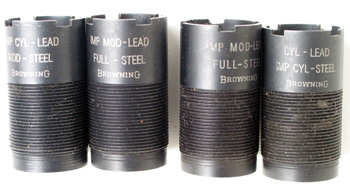
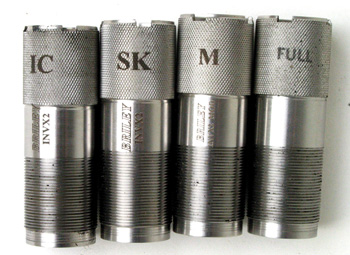 The traditional clay target events of Trap (Down the Line) and Skeet are shot with specific chokes and specific shot sizes. On set-up for the match, the DTL shooter may use a modified and full combination while the Skeet shooter invariably uses skeet chokes in both barrels.
The traditional clay target events of Trap (Down the Line) and Skeet are shot with specific chokes and specific shot sizes. On set-up for the match, the DTL shooter may use a modified and full combination while the Skeet shooter invariably uses skeet chokes in both barrels.
The development of more varied programs such as Sporting Clays and SSAA 5-Stand, presents the shooter with a far greater range of permutations because of the variety of targets in each of these events. It is not uncommon for shooters to change chokes from station to station, but serious competitors are more likely to use a range of special loads designed to accommodate specific target conditions.
Very few shotgunners take the trouble to pattern their guns. Serious clay target shooters are usually the exception. Most clay target clubs have pattern boards available. Some chokes may not deliver uniform patterns while others may not deliver the shot pattern to the point of aim. Some guns may prefer a particular batch or brand of shotshell.
Rifle shooters will always sight their rifle before going afield and shotgunners should do the same to find out how the chokes are performing with the selected loads, and equally as importantly, where the centre of the pattern is falling.
Sometimes changing chokes may change the point of impact and shotgunners need to know about such things to avoid unnecessary disappointment.
There are other factors related to choke performance that beginners need to be aware of. While the overall choke performance is important, the even distribution of shot within the choke zone is equally important.
Patterns that have ‘holes’ in them will allow targets to escape, although the shot may be well placed, so uniform patterns can be equally as important as the degree of choke.
Another thing to remember is that while a shot pattern looks two-dimensional on a pattern board, the shot is three-dimensional when in the air. The length of the shot string is to some degree determined by the choke, as tighter chokes may produce longer shot strings.
The shot string may be 100cm or more long, although very specialised equipment is required to determine characteristics such as this.
Selecting the right choke for a particular job is also partially determined by the shot size involved. For example, using 9-shot in a full choke barrel will produce a very dense pattern with a large number of very small pellets, which do not have much energy left after 35 metres. This is contrary to conventional wisdom in using full choke barrels.
At the other extreme, using 2-shot in a Skeet choke would produce a very sparse pattern at 35 metres, through which many targets could fly without striking a pellet.
Table 3 shows the pellet count for the various shot sizes. This is to give some idea of how many pellets in each size would end up in the designated zone for each choke size shown in Table 1.
As a basic rule for beginners, use as big a choke as possible that will do the job with the shot size you plan to use.
If all your shots are less than 30 metres, you don’t need a full choke. If you are shooting at aerial targets no closer than 45 metres, only a full choke will do the job. Larger shot sizes are best used with tighter chokes because of the lesser number of pellets in the pattern, just as small shot is best used in more open chokes as the pellets are so light that they will be ineffective at longer ranges anyway.
With six common shot sizes and five standard choke sizes in a double-barrelled shotgun, there are more than enough permutations and combinations to experiment with, until you can find the ones that work best.
| Table 1: Choke constrictions and designations | |||||
| Constriction (mm) | Constriction (inches) | British Designation | European Designation | US Designation | Pattern at 36 metres |
| 0.00 | 0.00 | Cylinder | CL | Cyl | 40 |
| 0.25 | 0.01 | ¼ | ++++ | Improved Cyl | 50 |
| 0.50 | 0.02 | ½ | +++ | Modified | 60 |
| 0.75 | 0.03 | ¾ | ++ | Improved Mod | 65 |
| 1.00 | 0.04 | Full | + | Full | 70 |
| Table 2: Bore diameters - British proof law | |
| Gauge Number | Bore Diameter (inches) |
| 4 | 1.052 |
| 8 | 0.835 |
| 10 | 0.775 |
| 12 | 0.729 |
| 16 | 0.662 |
| 20 | 0.615 |
| 28 | 0.550 |
| Table 3: Pellet count for various shot sizes | ||||||||
| Shot Size | 9 | 8 ½ | 8 | 7 ½ | 6 | 5 | 4 | 2 |
| Pellet count - 28gm load | 585 | 485 | 410 | 350 | 225 | 170 | 135 | 90 |
| Pellet weight grains | 0.75 | 1.07 | 1.10 | 1.25 | 1.94 | 2.57 | 3.24 | 4.87 |
| Pellet diameter (mm) | 2.30 | 2.16 | 2.29 | 2.41 | 2.79 | 3.08 | 3.30 | 3.81 |
Captions
Image 1: Chokes are vital for controlling the pattern of the shot, especcially for clay/skeet shooting. Without the correct choke, the pattern may be too sparse and the targets could pass through without being struck by a pellet.
Image 2: This illustration shows the different types of choke configurations; jug choking is at the top.
Image 3: John Robinson uses both Briley and Mirochokes in this Miroku 9000. The difference in length results in the Briley’s protruding from the muzzle.
Image 4: Miroku, Browning and a number of other shotgun makers use shorter screw-in chokes such as these Mirochokes. As well as the etched ID, these chokes also have notches on the leading edge to designate the choke size, from 1 = full to 5 = skeet.
Image 5: Briley screw-in chokes have a strong following. The longer choke length improves performance. Choke designations are etched on the tubes.
